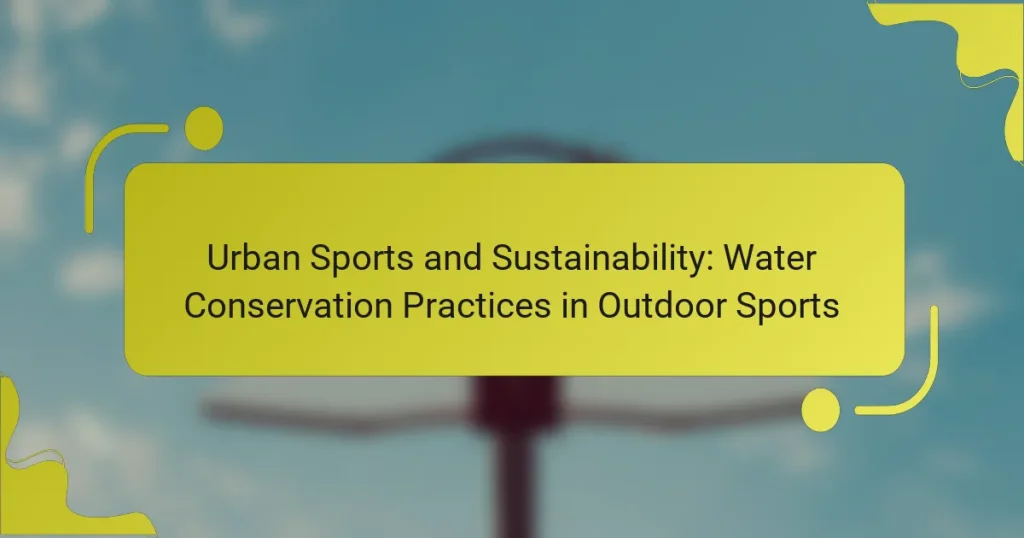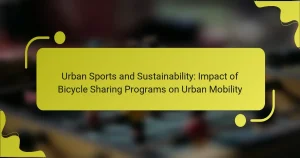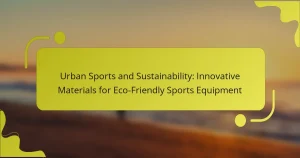Urban sports play a crucial role in promoting sustainability through effective water conservation practices. They encourage eco-friendly behaviours, utilise innovative technologies, and foster community collaboration. Key strategies include smart irrigation systems, rainwater harvesting, and education on conservation. Organisations like the International Olympic Committee and local councils lead initiatives to enhance awareness and implement sustainable practices in urban sports settings.
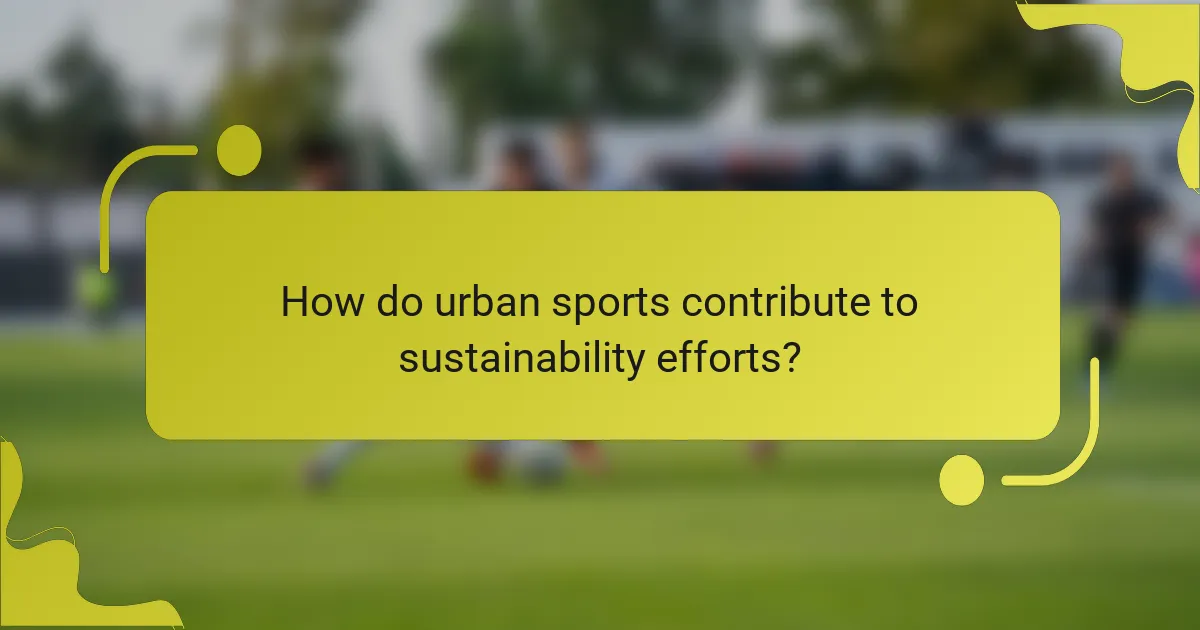
How do urban sports contribute to sustainability efforts?
Urban sports contribute to sustainability efforts by promoting water conservation practices. These activities often utilise natural environments, encouraging participants to engage in eco-friendly behaviours.
For example, urban sports like parkour and outdoor climbing often emphasise the importance of preserving local water resources. Participants are motivated to adopt practices such as minimising water usage during events and advocating for green spaces that enhance water retention.
Additionally, many urban sports communities collaborate with local governments to implement sustainable water management strategies. This includes creating rain gardens and permeable surfaces that reduce runoff and improve water quality.
Ultimately, urban sports serve as a platform for raising awareness about water conservation, fostering a culture of sustainability among participants and spectators alike.
What are the environmental impacts of urban sports?
Urban sports can significantly impact the environment, primarily through water conservation practices. These activities often take place in urban areas where water resources are limited. Implementing water-efficient practices, such as using permeable surfaces in skate parks or promoting drought-resistant landscaping in sports facilities, helps reduce water consumption.
Additionally, urban sports can encourage community awareness about sustainability. Events like parkour or outdoor yoga classes often highlight the importance of maintaining green spaces, which contributes to better water management in cities.
As a result, integrating water conservation into urban sports not only enhances the sustainability of these activities but also fosters a culture of environmental responsibility. This approach helps mitigate the ecological footprint of urban sports and promotes a healthier urban ecosystem.
Which urban sports promote water conservation?
Urban sports that promote water conservation include activities like skateboarding, parkour, and cycling. These sports often utilise urban spaces that require minimal water use for maintenance.
Skateboarding relies on concrete parks, which do not require irrigation. Parkour emphasises natural urban elements, reducing the need for landscaped areas. Cycling encourages less reliance on motor vehicles, promoting environmental sustainability.
Engaging in these sports fosters a community awareness of resource conservation. Participants often support local initiatives that focus on sustainable practices, further enhancing their impact on water conservation.
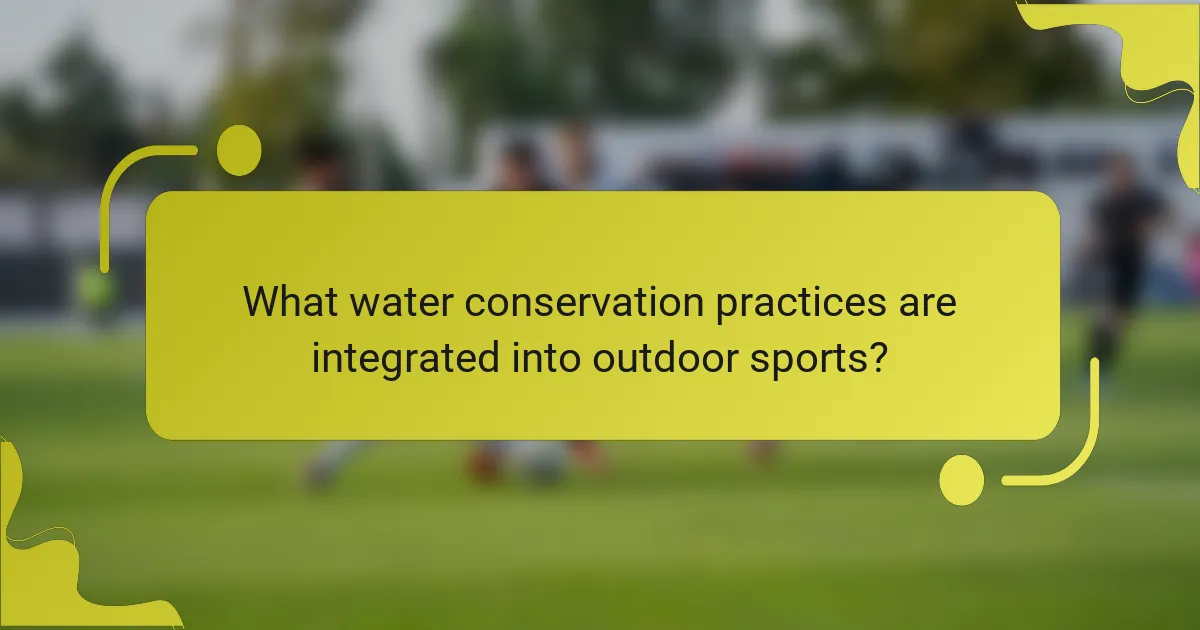
What water conservation practices are integrated into outdoor sports?
Outdoor sports integrate various water conservation practices to promote sustainability. Techniques include using drought-resistant turf, implementing rainwater harvesting systems, and utilising smart irrigation technologies. These methods reduce water usage while maintaining the quality of sports facilities. Additionally, education programmes raise awareness among athletes and spectators about the importance of water conservation in outdoor sports.
How do athletes and organisations implement water-saving techniques?
Athletes and organisations implement water-saving techniques by adopting efficient practices and technologies. These include using drought-resistant landscaping, installing rainwater harvesting systems, and employing smart irrigation systems. For example, many sports facilities now utilise greywater recycling to reduce fresh water consumption. Additionally, awareness campaigns educate athletes on responsible water use during training and events. These strategies not only conserve water but also promote sustainability in outdoor sports.
What role do local governments play in promoting water conservation in sports?
Local governments play a crucial role in promoting water conservation in sports by implementing policies, providing resources, and facilitating community engagement. They establish regulations that encourage water-efficient practices in sports facilities and public parks. For example, they may incentivise the use of drought-resistant landscaping or rainwater harvesting systems. Additionally, local governments often conduct educational programmes to raise awareness about the importance of water conservation among athletes and sports organisations. This collaborative approach fosters sustainable practices that benefit both the environment and the community.
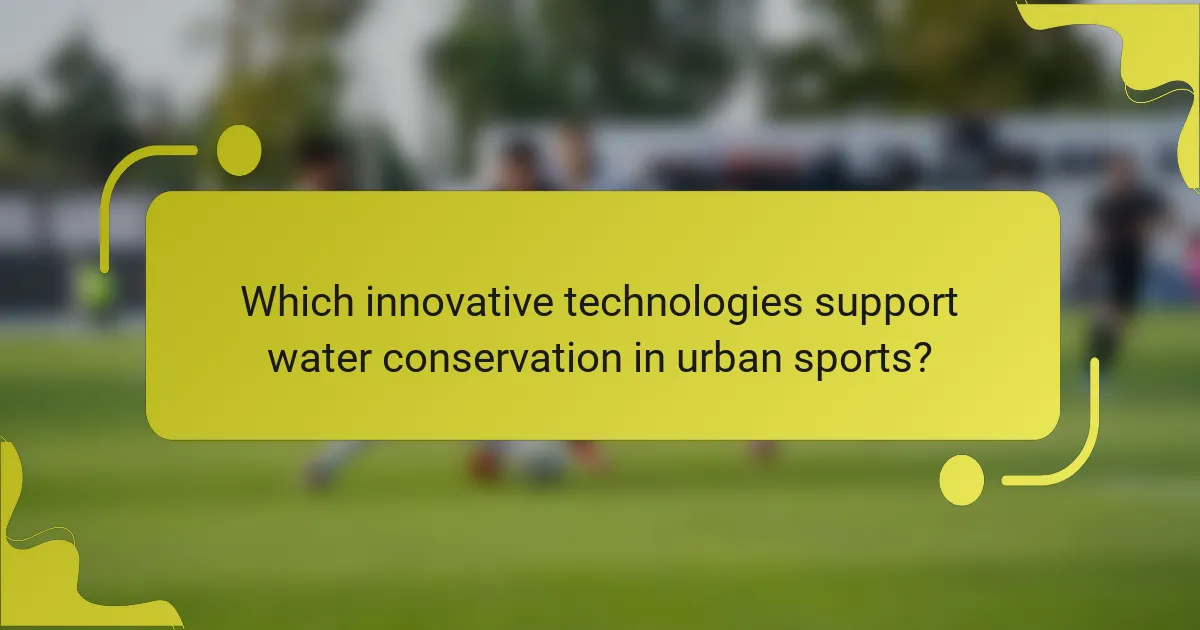
Which innovative technologies support water conservation in urban sports?
Innovative technologies supporting water conservation in urban sports include smart irrigation systems, rainwater harvesting, and water-efficient turf. These technologies optimise water usage and enhance sustainability in outdoor sports facilities. Smart irrigation systems use sensors to monitor soil moisture, ensuring precise watering. Rainwater harvesting captures runoff for irrigation, reducing reliance on municipal water. Water-efficient turf varieties require less water and withstand drought conditions, promoting conservation. Together, these technologies significantly lower water consumption in urban sports.
How does smart water management enhance outdoor sporting events?
Smart water management significantly enhances outdoor sporting events by optimising resource use and reducing waste. Effective strategies include rainwater harvesting and efficient irrigation systems, which conserve water while maintaining high-quality playing conditions. Sustainable practices can lead to cost savings and improved environmental impact, fostering community support. For instance, events utilising smart water management can reduce water usage by up to 30%, showcasing a commitment to sustainability in urban sports.
What examples exist of successful water conservation technologies in sports?
Successful water conservation technologies in sports include rainwater harvesting systems, smart irrigation technology, and water-efficient turf management. These innovations help reduce water consumption while maintaining field quality. For example, the use of smart irrigation systems can lead to a 30% reduction in water usage. Additionally, some stadiums are implementing greywater recycling systems to repurpose water for non-potable uses. These practices not only conserve water but also promote sustainability in urban sports environments.
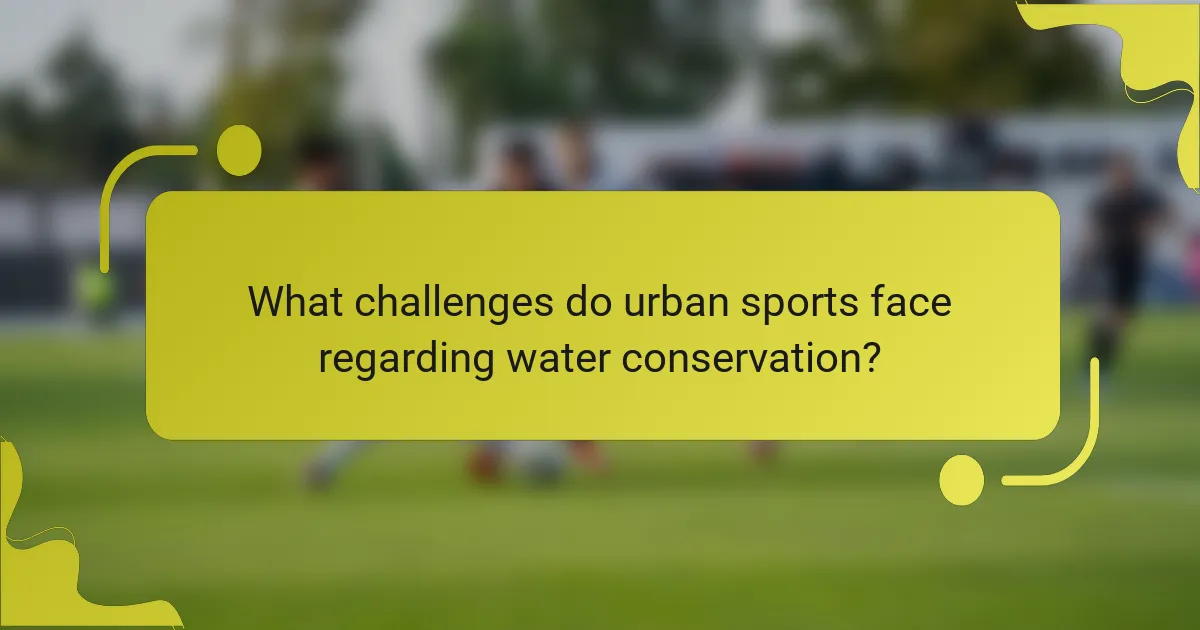
What challenges do urban sports face regarding water conservation?
Urban sports face significant challenges in water conservation due to their high demand for outdoor facilities and maintenance. Limited access to water resources, coupled with climate change, exacerbates these issues. Additionally, urban infrastructure often prioritises development over sustainable practices, leading to inefficient water use. Innovative solutions, such as rainwater harvesting and drought-resistant landscaping, are essential for addressing these challenges. Collaboration between sports organisations and local governments can enhance water conservation efforts in urban sports settings.
How do climate change and urbanisation impact water availability for outdoor sports?
Climate change and urbanisation significantly reduce water availability for outdoor sports. Increased temperatures and urban sprawl lead to higher water demand and decreased supply.
Urbanisation often results in impervious surfaces, reducing groundwater recharge. This impacts water access for sports facilities and recreational spaces. Climate change exacerbates these issues through altered precipitation patterns, leading to droughts and water scarcity.
Water conservation practices are essential for sustaining outdoor sports. Implementing rainwater harvesting, efficient irrigation systems, and drought-resistant landscaping can mitigate water shortages. These practices not only support sports but also promote environmental sustainability.
What are common misconceptions about water usage in urban sports?
Common misconceptions about water usage in urban sports include the belief that all outdoor activities require excessive water and that conservation efforts are unnecessary. Many assume that sports fields and facilities are always over-watered, ignoring sustainable practices like rainwater harvesting and drought-resistant landscaping. Additionally, some think that water conservation negatively impacts sports quality, while in reality, efficient water use can maintain field conditions effectively. Understanding these misconceptions is crucial for promoting sustainable practices in urban sports environments.
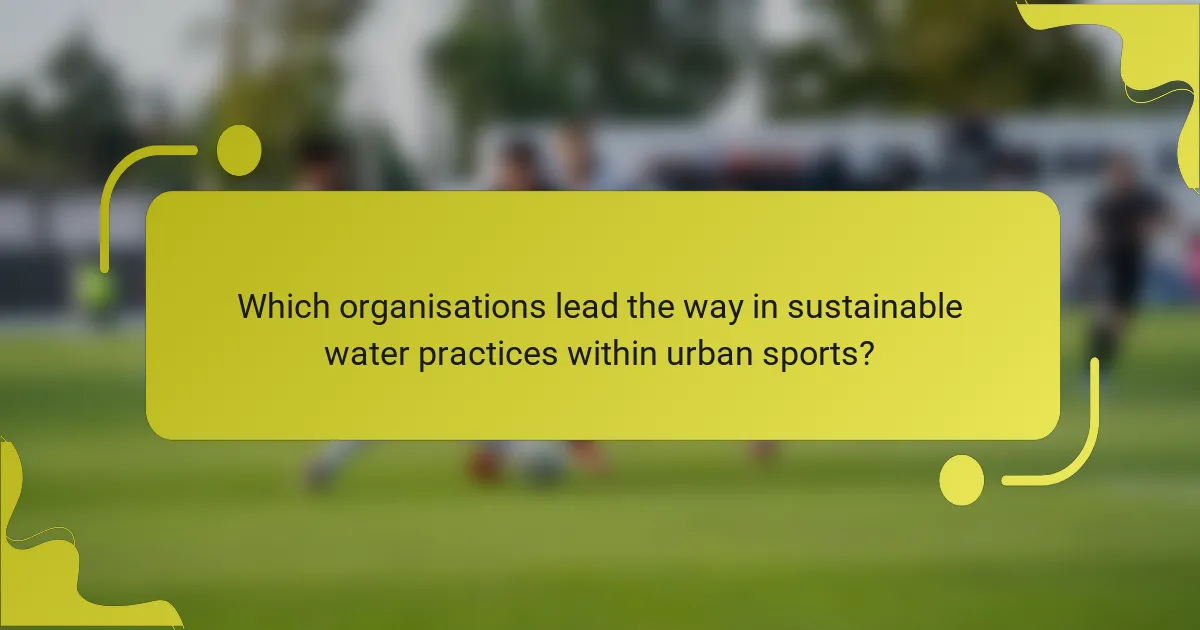
Which organisations lead the way in sustainable water practices within urban sports?
Organisations leading in sustainable water practices within urban sports include the International Olympic Committee, the World Wildlife Fund, and local city sports councils. These entities implement innovative water conservation strategies, promoting eco-friendly facilities and practices. For example, the International Olympic Committee emphasises sustainable event management, focusing on water-efficient technologies. The World Wildlife Fund collaborates with urban sports organisations to develop water stewardship programmes. Local councils often initiate community-based projects to enhance water conservation awareness among athletes and spectators.
How do local initiatives foster community engagement in water conservation?
Local initiatives significantly enhance community engagement in water conservation through collaborative programmes and education. These initiatives often involve local sports organisations promoting sustainable practices, such as rainwater harvesting and efficient irrigation. For example, community sports events can incorporate water conservation themes, encouraging participants to adopt eco-friendly habits. As a result, awareness increases, fostering a collective responsibility towards water resources. Community workshops and clean-up drives further strengthen involvement, creating a culture of sustainability that benefits both outdoor sports and local ecosystems.
What partnerships exist between sports organisations and environmental agencies?
Partnerships between sports organisations and environmental agencies focus on promoting sustainability and water conservation in outdoor sports. Collaborative initiatives often include developing best practices for water management, implementing eco-friendly facilities, and engaging in community education programmes. For instance, organisations like the International Olympic Committee partner with environmental groups to ensure sustainable practices in event planning and execution. These partnerships enhance the environmental impact of sports while fostering community involvement and awareness.
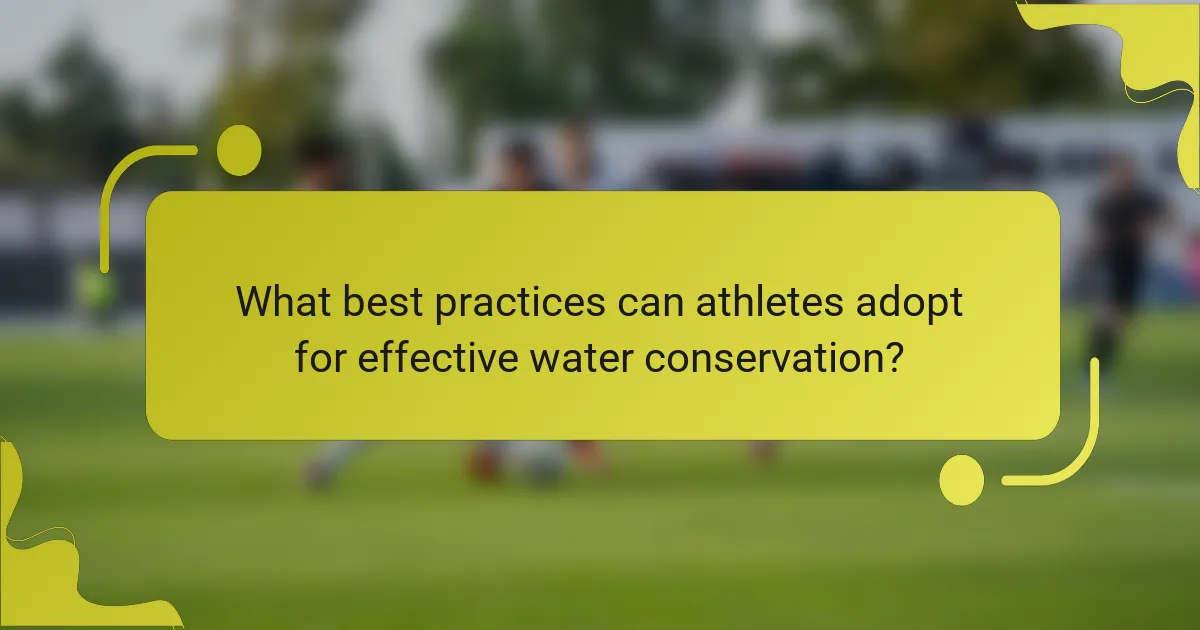
What best practices can athletes adopt for effective water conservation?
Athletes can adopt several best practices for effective water conservation in outdoor sports. Prioritise using refillable water bottles to reduce single-use plastic waste. Schedule training sessions during cooler parts of the day to minimise evaporation and water loss. Implement water-efficient irrigation techniques for training fields, such as drip irrigation. Educate teammates about the importance of conservation and encourage collective efforts to monitor water usage. Lastly, participate in local initiatives that promote sustainable water practices within the community.
How can sports events be designed to minimize water waste?
Sports events can be designed to minimise water waste through efficient planning and sustainable practices. Implementing rainwater harvesting systems can capture and reuse water for irrigation. Utilising drought-resistant landscaping reduces the need for excessive watering. Scheduling events during cooler months lowers evaporation rates. Educating participants about water conservation fosters responsible usage. Lastly, using water-efficient fixtures in facilities significantly decreases overall consumption.
What are the key takeaways for promoting sustainability in urban sports?
Promoting sustainability in urban sports requires implementing effective water conservation practices. Key takeaways include utilising rainwater harvesting systems, encouraging the use of drought-resistant landscaping, and promoting eco-friendly sports equipment. Collaboration with local governments can enhance community awareness. Regular assessments of water usage in facilities can identify areas for improvement. Engaging athletes in sustainability initiatives fosters a culture of environmental responsibility.
